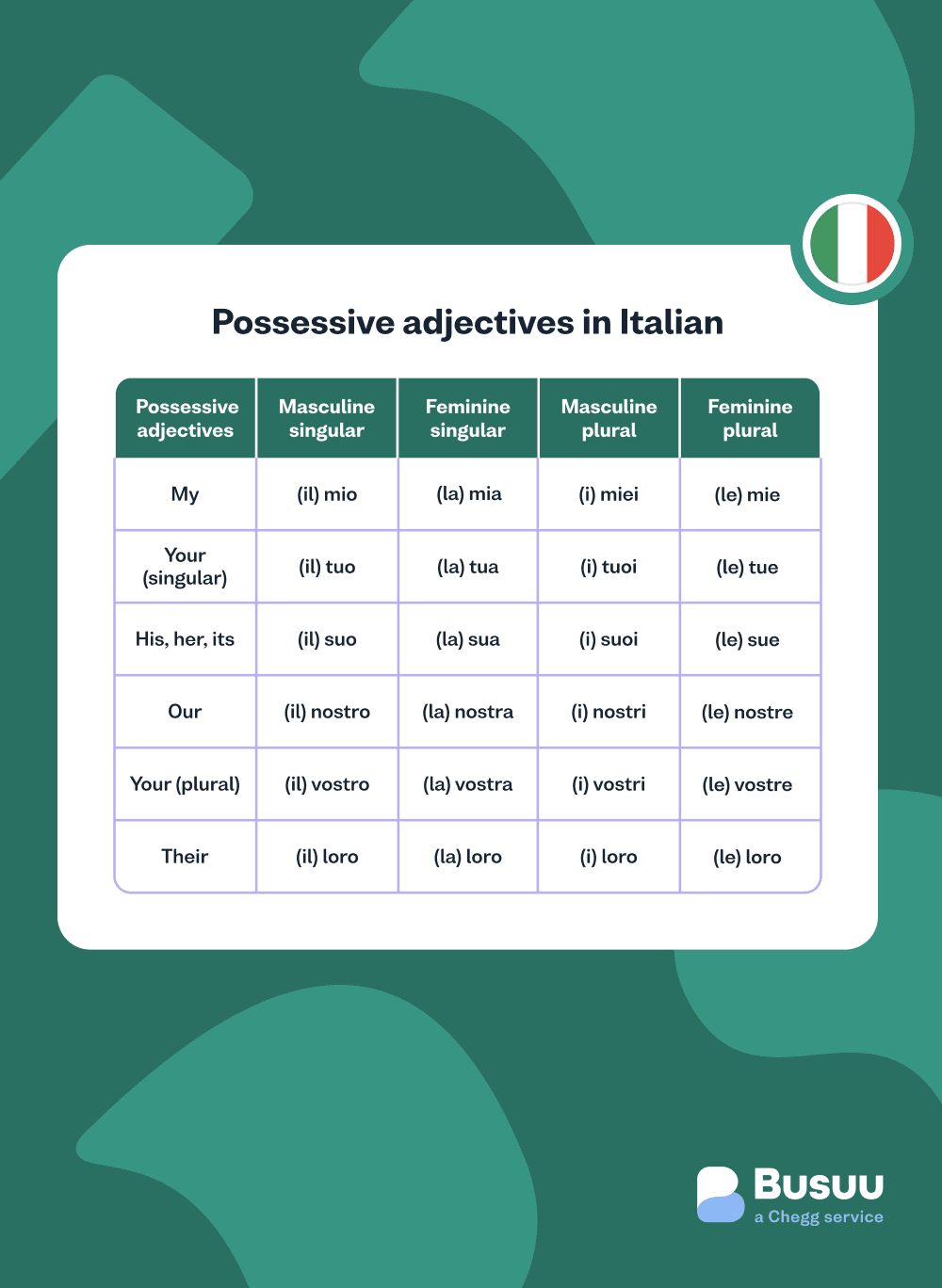I want to learn...
Possessive adjectives in Italian or aggettivi possessivi are the adjectives that tell us who or what owns something. In English, we say “my bag” or “your dog” or “his jacket”. We only have eight different possessive adjectives, but Italian has a grand total of 24!
Don’t worry! Let’s look at possessive adjectives in Italian and how to use them, and you’ll be comfortable with them in no time.
What are possessive adjectives in Italian?
First things first. Italian possessive adjectives will change depending on:
Whether the noun you’re talking about is singular or plural.
Whether the noun you’re talking about is masculine or feminine.
Remember: Nouns always have an assigned gender in Italian, so they will have either a masculine or feminine attribute. You can tell if something is masculine if it has an il, i, lo, or gli article before it. If it has la or le, it’s feminine. You can also usually tell if the noun ends in an -o (masculine) or an -a (feminine), but there are exceptions.
In English, our possessive adjectives don’t agree with the nouns they refer to.
Here are examples:
my boy
my girl
my boys
my girls
See how the possessive adjective “my” doesn’t change?
Let’s see what they look like in Italian. (Quick tip, it’s worth reviewing Italian pronouns so we recommend checking out our guide to Italian pronouns.)
Here are all 24 of the possible Italian possessive adjectives:

All possessive adjectives in Italian
| My | Your (singular) | His, her, its | Our | Your (plural) | Their | |
|---|---|---|---|---|---|---|
| Masculine Singular | mio | tuo | suo | nostro | vostro | loro |
| Feminine Singular | mia | tua | sua | nostra | vostra | loro |
| Masculine Plural | miei | tuoi | suoi | nostri | vostri | loro |
| Feminine Plural | mie | tue | sue | nostre | vostre | loro |
There are four possible forms for every subject (io, tu, noi, etc.) and that’s why Italian has so many possessive adjectives compared to English.
Notice how loro (their) doesn’t change, no matter the gender or number of the noun it modifies. It’s the one exception.
Before you start plugging these into sentences, let’s clear up one important rule.
Gender and number follow the noun, not the subject
In English, when we are talking about something belonging to a man, we say “his”. When it belongs to a woman, we say “her”.
This isn’t how it works in Italian. It doesn’t matter what gender the subject is, the possessive adjective is based on the noun it refers to.
For example, if you are talking about your uncle’s house, you would say la sua casa because “house” is feminine in Italian. And if you’re talking about his multiple houses (how lucky!), you would say le sue case (his houses). It doesn’t matter that he’s a man, you’ll use the feminine possessive adjective.
Note: Take the word for bathroom, which is bagno (pronounced ban-yo). Bagno is masculine, so it uses the masculine possessive adjectives mio and miei.
il mio bagno (my bathroom)
i miei bagni (my bathrooms)
On the flipside, bag in Italian is borsa. It’s always feminine, so it’s time to use the feminine possessive adjectives mia and mie.
la mia borsa (my bag)
le mie borse (my bags)
The plural subjects,noi (we) and voi (you), will also follow this rule.
Example of plural subjects and their possessive adjectives
| Masculine | Feminine |
|---|---|
| il nostro libro (our book) | la nostra sedia (our chair) |
| i nostri libri (our books) | la nostre sedie (our chairs) |
| il vostro libro (your book) | la vostra sedia (your chair) |
| i vostri libri (your books) | le vostre sedie (your chairs) |
Remember,loro (their) doesn’t change at all.
La loro borsa (their bag)
Le loro borse (their bags)
Il loro libro (their book)
I loro libri (their books)
Possessive adjectives need an article before them
Think of Italian possessive adjectives as needy — they can’t go alone. They need an article in front of them. It doesn’t matter whether the article is definite (the: il, i, gli, lo, la or le) or indefinite (a: un, uno, una, un’), although it’s more likely to be a definite article. We recommend reviewing our guide on Italian articles first.
Lei è una mia maestra. (She is a teacher of mine.)
Lui è il nostro amico. (He’s our friend.)
Il vostro gatto ha le strisce. (Your cat has stripes.)
È un suo dipinto. (It’s a painting of his.)
I tuoi capelli sono molto lunghi. (Your hair is very long.)
Sono i loro zaini. (They are their backpacks.)
Do you always need an article before a possessive adjective?
There is an exception—when referring to a singular close family member, like a mother, daughter, sister, husband, father, etc.
In that case, there doesn’t need to be any article before a possessive adjective.
Here are some examples:
Mia madre è bella. (My mother is beautiful.)
Mio figlio è gentile. (My son is kind.)
Nostro zio lavora in Spagna. (Our uncle works in Spain.)
However, if there’s any qualifying adjective or term of endearment, you’ll need to add that possessive article back in.
La mia sorellina vive negli Stati Uniti. (My little sister lives in the United States).
Il mio caro nonno amava il cioccolato. (My dear grandfather loved chocolate.)
If you’re talking about multiple close family members, then you must use the article before the possessive adjective, too.
Le mie cugine sono divertenti. (My cousins are funny.)
I miei genitori hanno una macchina. (My parents have a car.)
And, finally, if the possessive adjective isloro(their), it must have that article before, no matter if it’s a close family member.
Il loro papà cucina ogni sera. (Their father cooks every night.)
I loro nonni hanno comprato una casa. (Their grandparents bought a house.)
Usually the possessive adjective goes before the noun, but if you want to add emphasis or add a slightly ironic tone, then you can put it after. It’s most commonly expressed in exclamations:
Caro mio! (My dear!)
Dio mio! (My God! Or good heavens!)
Mamma mia! (Oh my god. Literally: My mother!)
Do we always need to use a possessive adjective?
Not always. There are two situations where it’s not necessary to use the possessive adjective:
If the owner is clear from the context.
Dopo il lavoro prenderò la macchina. (After work, I’ll take my car.)
Indosso il vestito. (I’m wearing my dress.)When referring to body parts (because the relationship between the noun and owner is obvious).
Mi sto lavando le mani. (I’m washing my hands.)
Si è fatto male a una gamba. (He hurt his leg.)
There we have it! Knowing how to use possessive adjectives in Italian will make your conversations much more natural and clearer. Now you can tell your friend that the last pizza slice is yours, not theirs. (Or, if you want to be nice, you can say it’s all theirs.)
At Busuu, we believe you should never stop learning. That’s why we help Italian learners progress in their practical language skills, so they can reach their fullest potential.
Ready to level up your Italian?
They didn’t build Rome in a day—and learning Italian will take more than a day, too. We’re Busuu, the language-learning app – and we help people reach their language goals. Reach your language goals with our award-winning online courses, support from our community of Italian speakers, and more.
Newlanguages


